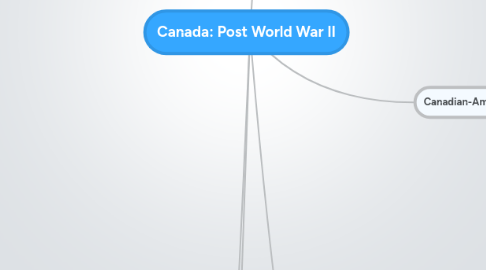
1. Social Changes in Canada
1.1. Women's Rights
1.1.1. Womens's Liberation Movement
1.1.1.1. Feminists
1.1.1.1.1. Mainstream
1.1.1.1.2. Radical
1.1.2. Women in Govt
1.1.2.1. Jeanne Sauve
1.1.2.1.1. first women speaker of the house
1.1.2.1.2. first female GG
1.1.2.2. Kim Campbell
1.1.2.2.1. first female PM
1.1.3. Women in the workforce
1.1.3.1. 1980 48% of women employed outside of home
1.1.3.2. enter new fields that were previously for men only
1.1.4. Legislative Change
1.1.4.1. 1970-discriminaton is illegal
1.1.4.2. 1976 maternity leave laws
1.1.4.3. equal work for equal pay
1.1.4.4. child tax credit
1.2. Medicare
1.2.1. 90% of doctor's go on strike
1.2.1.1. launch campaign against government and medicare
1.2.1.2. fear of being turned into public servants
1.2.2. 10 years later Medicare is federal
1.3. Immigration
1.3.1. 1952 Immigration Act
1.3.1.1. Country needs labour, accepts immigrants again a few years later
1.3.2. Canadian Multiculturalism Act
1.3.3. In sync with business cycle
2. Canadian Economics
2.1. 1970s
2.1.1. Double digit inflation
2.1.2. Opec Crisis
2.1.2.1. Raise in oil prices (demand > supply)
2.1.2.2. Unions form for better wages
2.1.2.2.1. CAD gov dept increases
2.2. Post War -1960s
2.2.1. Alberta has strongest economy
2.2.1.1. Discovery of mining and oil
2.2.2. Veterans
2.2.2.1. Low interest rate
2.2.3. increased industrial capacity
2.3. 1980s-1990s
2.3.1. Massive dept
2.3.1.1. Strengthen private sector
2.3.1.1.1. help reduce deficit
2.3.1.2. consumer goods to service industry
2.3.1.2.1. % in poverty increases
2.3.1.3. Neo conservatism
2.3.1.3.1. reduce government involvement in economics
2.3.1.3.2. increase market reliance
2.3.1.4. NAFTA
2.3.1.4.1. increases trade + investment
2.3.1.4.2. jobs lost b/c of relocation
2.3.1.4.3. companies sold to US or Mexico
2.3.1.5. Liberal Party
2.3.1.5.1. vow to end deficit, govt by 1998
2.4. Foreign Aid
2.4.1. $2 billion to rebuild W. Europe
2.4.2. Communism Containment
2.4.2.1. Food, equipment, raw materials
2.4.3. CIDA
2.4.3.1. ODA
2.4.3.1.1. bilateral support
2.4.3.1.2. supports non govt organizations
2.4.3.1.3. supports private sector enterprises
2.4.3.1.4. supports multilateral institutions
2.4.3.1.5. dropped 34 % in the last 15 years
2.4.4. Colombo Plan
2.4.4.1. foreign aid to ither commonwealth
3. International Affairs
3.1. Cold War
3.1.1. The Gouzenko Affair
3.1.1.1. Gouzenko Affair
3.1.1.1.1. USSR embassy clerk reveals 2 spy rings in Canada
3.1.1.1.2. spends life in Canadian protection
3.1.1.1.3. Communist threat in Canada
3.1.2. Red Scare
3.1.2.1. RCMP carries out illegal & secret inquiries regarding communists
3.1.2.2. Imigrants denied entry into Canada
3.1.2.3. Communists are deported from Canada
3.1.3. The Korean War
3.1.3.1. 26,500 Canadians serve, 100 wounder, 400 killed
3.1.4. Cyprus
3.1.4.1. Canadian troops stationed for 29 years
3.1.4.2. Canada contributes $600 million and 30 Canadian soldiers die
3.1.5. Middle East Conflict
3.1.5.1. peacekeeping troops were sent to the region
3.1.6. Recognition of Communist China
3.1.7. Vietnam War
3.1.7.1. Canada does not support it
3.1.7.2. Protests in Canada against it
3.2. International Organizations
3.2.1. La Francophonie
3.2.1.1. link between former French colonies
3.2.1.2. sets up billingualism in Candada
3.2.1.3. Canada is a founding member
3.2.1.4. A Canadian is the first president
3.2.2. NATO
3.2.2.1. mutual defense
3.2.2.2. to prevent Soviet expansion
3.2.2.3. Canada contributes to the defense force
3.2.3. NORAD
3.2.3.1. 3 radar lines in Canada's North
3.2.4. UN
3.2.4.1. Canada's peacekeeping role acts after its approval
3.2.5. ACCT
3.2.5.1. Canada is a founding member
3.3. Peacekeeping in Recent Overseas Conflict
3.3.1. The Persian Gulf War
3.3.1.1. Canada sends ships & fighter planes to patrol the Persian gulf
3.3.2. Yugolavia, 1992
3.3.2.1. Canadians attacked by Croatian soldiers
3.3.2.2. Canadians launch a full scale assault to reoccupy the ceasefire zone
3.3.3. Somalia, 1992
3.3.3.1. Canadian government disbands CAR
3.3.3.2. damages reputation of Canadian individuals, military, and nation
3.3.4. NATO bombing of Kosovo
3.3.4.1. Canadian warplanes were amongst the NATO ones that continuosly bombed Yugoslovakia military & communication targets
3.3.4.2. Canadians working under UN order (mandate) enter to peacekeep
4. Canadian-American Relations
4.1. Cold War
4.1.1. Defense
4.1.1.1. NATO
4.1.1.2. DEW line, Mid Canda Pinetree Line, North Warning System
4.1.1.3. NORAD
4.1.1.3.1. Canada contributes $300 million
4.1.1.3.2. Phases out Bombard missiles & nuclear warheads
4.1.1.4. Weapons
4.1.1.4.1. Avrow Arrows
4.1.1.4.2. Bomarc missiles
4.1.1.5. SDI
4.1.1.5.1. US proposal of defensive umbrella
4.2. Projects
4.2.1. St. Lawrence Seaway
4.2.2. Pacific Salmon Wars
4.2.2.1. CAD/US arguement over west coast fish
4.2.2.2. Pacific Salmon Treaty of 1985
4.2.2.3. 1999 New Treaty
4.2.2.3.1. not signed by BC
4.2.3. Canadarm
4.2.3.1. sold to NASA
4.3. Economic Ties
4.3.1. Auto Pact
4.3.1.1. free car imports between Canada and US
4.3.1.2. lower car costs
4.3.1.3. US investment in Canadian automotive
4.3.2. Growing US influence
4.3.2.1. 70% of Canadian products sold in US
4.4. War
4.4.1. War on Terror
4.4.1.1. Opeation Support
4.4.1.1.1. provides aircraft divertde to Canadian airfields
4.4.1.2. Operation Apollo
4.4.1.2.1. Candian military campaign against terrorism
4.4.1.2.2. supports American Operation on enduring freedon
4.4.2. War on Iraq
4.4.2.1. Canada will only take military action if UN approves
4.4.2.2. US continues without UN support
4.4.2.3. Canada has given $100 million to humanitarian assistance in Iraq
5. Canadian Politics
5.1. Liberal Party
5.1.1. Louis St. Laurent
5.1.1.1. St. Lawrence Seaway
5.1.1.2. Trans Canada Highway
5.1.1.3. Trans Canada Natural Gas Pipeline
5.1.1.4. Encourages Newfoundland & Labrador to join confederation (succeeds)
5.1.2. Lester B. Pearson
5.1.2.1. Canadian Pension Plan
5.1.2.2. Publicly funded Medicare
5.1.2.3. New Canadian Flag
5.1.2.4. Royal Billingualism Comission
5.1.3. Pierre Trudeau
5.1.3.1. Official Languages Act of 1969
5.1.3.2. Income Tax Cuts
5.1.3.3. Poor & Elderly Benefits
5.1.4. Jean Chrétien
5.1.4.1. Budget Surplus within 5 years of election
5.2. Progressive Conservative Party
5.2.1. John Diefenbaker
5.2.1.1. Canadian Bill of Rights
5.2.1.2. Raises pensions
5.2.1.3. Financial aid to farmers
5.2.2. Brian Mulroney
5.2.2.1. Canada Health Act
5.2.2.2. Neo Conservatism
5.2.3. Kim Campbell
5.2.3.1. Takes over after Mulroney resigns
5.3. New Political Parties
5.3.1. Bloc Québecois
5.3.1.1. Seeks to make Quebec an independant nation
5.3.1.2. Led by Lucien Bouchard
5.3.1.3. Official opposition in 1993
5.3.2. Reform Party
5.3.2.1. Western Discontent
5.3.2.2. Against billingualism & Quebec priviliges
5.3.2.3. Official opposition in 1997
